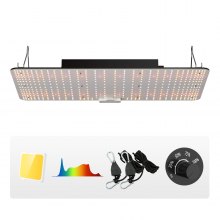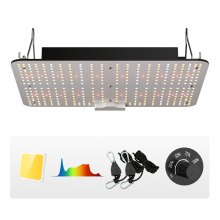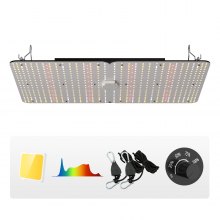Explore Grow Lights in Vertical Farming and Urban Agriculture With VEVOR
The past years have ushered in a new era of sustainable agriculture and food production, particularly urban farming. VEVOR, always known to take a front row in innovative technology, recognizes the essentiality of vertical farming early and, as such, puts a heavy weight behind it.
As traditional farming faces challenges like land scarcity, climate change, and a growing global population, innovative techniques like vertical farming have become imperative. As such, other innovations like the grow lights become essential to increase the efficiency of the new agricultural techniques. Grow lights are now major sights in rooftop gardens, indoor farming, etc.
Different Applications Of Grow Lights
As technology evolves, grow lights play an increasingly integral role in agriculture and food production. However, its uses are not limited to growing food. It has diverse applications, from agriculture to scientific research.
Indoor Farming and Vertical Agriculture
Grow lights are widely utilized in indoor farming and vertical agricultural settings when natural sunlight is scarce or unavailable. Grow lights promote plant growth and development by delivering the appropriate light spectrum, allowing for year-round crop growing in regulated situations. Vertical farms, particularly, rely on grow lights to consistently light crops stacked in vertical layers, increasing space efficiency and production.
Greenhouses
In greenhouse farming, where sunshine may be insufficient due to seasonal fluctuations or geographic location, grow lights supplement natural light to ensure ideal plant growth conditions. Grow lights assist in lengthening the growth season, improve crop quality, and boost yields by delivering steady illumination independent of external circumstances such as weather conditions.
Research and Education
Grow lights are useful instructional tools, allowing students and academics to investigate plant biology, photosynthesis, and agricultural technologies. Grow light studies undertaken in schools, labs, and research institutes contribute to a better knowledge of plant growth processes and the influence of light on agricultural output.
Residential Gardening and Indoor Plants
Grow lights are becoming increasingly popular among home gardeners and indoor plant lovers who want to produce ideal growth conditions for houseplants, herbs, and veggies. Individuals may produce productive indoor gardens year-round, independent of exterior light conditions, thanks to the widespread availability of small and energy-efficient grow light systems.
Essential Accessories For Grow Lights
Setting up a grow light is never complete without some essential accessories. These accessories optimize performance and ensure safety. From the compulsory to the optional ones, they all serve cogent purposes.
Light Timer
A light timer is required to automate the on/off cycles of grow lights based on the individual light needs of plants. Timers assist in maintaining constant light schedules, ensuring that plants receive the proper quantity of light at each development stage without needing personal intervention.
Light Hangers or Ratchets
Light hangers or ratchets offer a secure and adaptable way to suspend grow lights from the ceiling or support structure. These hangers make it simple for producers to adjust the height of their grow lights to maintain the ideal space between the light source and the plants, eliminating light burn or shade.
Light Filters
Light filters, such as UV filters or color-correcting lenses, can change the wavelength of light output by grow lights. Filters enable gardeners to adjust the light spectrum to the unique needs of different plant species or growth phases, improving photosynthesis and plant growth.
How To Optimize Plant Growth with Effective Grow Light Setup
Putting a grow light in a place is not enough. You must ensure that they serve their purposes efficiently and optimize them well. Here are some tips for getting the best from your grow lights.
Choose The Right Grow Light And Positioning
Putting a grow light in your greenhouse does not guarantee your plant’s growth. Instead, you must consider the right grow light to choose by checking the light intensity, spectrum, and energy efficiency. Also, position the lights properly for uniform distribution to prevent light burn and shading.
Maintain a Natural Light Schedule
Consistently adjust the light spectrum and intensity, ensuring you have the right tone for every plant growth stage. Lining the greenhouse wall with reflective materials can also help maximize the light’s efficiency. You should maintain a consistent plant light schedule, mimicking the natural atmosphere.
Monitor Other Factors
Monitor the temperature and humidity levels, ensuring they are right for adequate growth. Provide other ventilation with fans or exhaust systems, if necessary. Also, keep a close eye on your plants, ensuring they respond favorably to the growth lights.
Why Choose VEVOR?
Choosing the right grow light involves choosing the suitable growth light with the best features from a reliable manufacturer. Considering these three, VEVOR has stood out as a great choice for growing light needs.
VEVOR’s grow lights were made with advanced technology, offering superior energy efficiency and longer lifespan. VEVOR's grow lights are designed to provide a customizable spectrum of light tailored to plants' specific needs at different growth stages.
VEVOR is a reliable manufacturer with nearly two decades of experience in tool-making and machining. With reliable products, customer-centric services, and after-sales support, purchasing from VEVOR is an excellent choice.
FAQs About Grow Lights
Are grow lights safe to use?
Yes, grow lights are typically safe per the manufacturer's recommendations. However, it is critical to adhere to safety rules, such as avoiding contact with water, utilizing surge protectors, and maintaining appropriate ventilation to minimize heat accumulation.
Do grow lights produce heat?
Some grow lights, such as HIDs, may generate a substantial quantity of heat. LED grow lights generate less heat, although they can still generate considerable warmth, especially at higher intensities. Effective airflow and temperature regulation are vital for maintaining ideal growth conditions and avoiding heat stress on plants.
Can I use regular household lights as grow lights?
While ordinary home lights can supply some light to plants, they may not provide the precise spectrum of light essential for maximum plant development. Grow lights are designed to produce the optimal wavelengths of light for photosynthesis, making them more effective for indoor gardening and plant culture.













































































